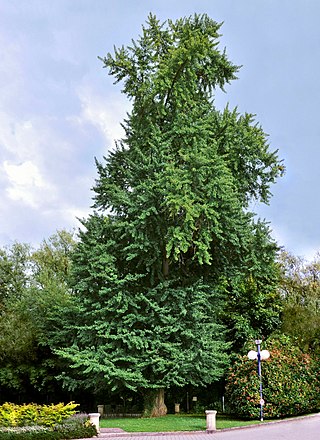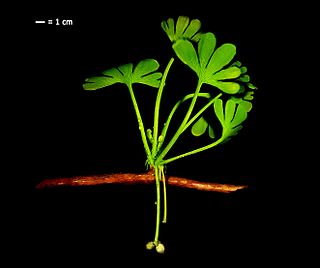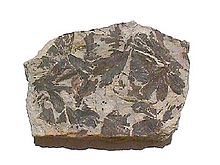The Mesozoic Era is the second-to-last era of Earth's geological history, lasting from about 252 to 66 million years ago, comprising the Triassic, Jurassic and Cretaceous Periods. It is characterized by the dominance of gymnosperms and of archosaurian reptiles, such as the dinosaurs; a hot greenhouse climate; and the tectonic break-up of Pangaea. The Mesozoic is the middle of the three eras since complex life evolved: the Paleozoic, the Mesozoic, and the Cenozoic.

Ginkgo biloba, commonly known as ginkgo or gingko, also known as the maidenhair tree, is a species of gymnosperm tree native to East Asia. It is the last living species in the order Ginkgoales, which first appeared over 290 million years ago, and fossils very similar to the living species, belonging to the genus Ginkgo, extend back to the Middle Jurassic epoch approximately 170 million years ago. The tree was cultivated early in human history and remains commonly planted, and is widely regarded as a living fossil.

Ginkgoales are a gymnosperm order containing only one extant species: Ginkgo biloba, the ginkgo tree. The order has a long fossil record extending back to the Early Permian around 300 million years ago from fossils found worldwide.

Cycads are seed plants that typically have a stout and woody (ligneous) trunk with a crown of large, hard, stiff, evergreen and (usually) pinnate leaves. The species are dioecious, that is, individual plants of a species are either male or female. Cycads vary in size from having trunks only a few centimeters to several meters tall. They typically grow very slowly and live very long. Because of their superficial resemblance, they are sometimes mistaken for palms or ferns, but they are not closely related to either group.

Gnetophyta is a division of plants, grouped within the gymnosperms, that consists of some 70 species across the three relict genera: Gnetum, Welwitschia, and Ephedra. The earliest unambiguous records of the group date to the Jurassic, and they achieved their highest diversity during the Early Cretaceous. The primary difference between gnetophytes and other gymnosperms is the presence of vessel elements, a system of small tubes (xylem) that transport water within the plant, similar to those found in flowering plants. Because of this, gnetophytes were once thought to be the closest gymnosperm relatives to flowering plants, but more recent molecular studies have brought this hypothesis into question, with many recent phylogenies finding them to be nested within the conifers.

The gymnosperms are a group of seed-producing plants that includes conifers, cycads, Ginkgo, and gnetophytes, forming the clade Gymnospermae. The term gymnosperm comes from the composite word in Greek: γυμνόσπερμος, literally meaning 'naked seeds'. The name is based on the unenclosed condition of their seeds. The non-encased condition of their seeds contrasts with the seeds and ovules of flowering plants (angiosperms), which are enclosed within an ovary. Gymnosperm seeds develop either on the surface of scales or leaves, which are often modified to form cones, or on their own as in yew, Torreya, Ginkgo. Gymnosperm lifecycles involve alternation of generations. They have a dominant diploid sporophyte phase and a reduced haploid gametophyte phase which is dependent on the sporophytic phase. The term "gymnosperm" is often used in paleobotany to refer to all non-angiosperm seed plants. In that case, to specify the modern monophyletic group of gymnosperms, the term Acrogymnospermae is sometimes used.

Bennettitales is an extinct order of seed plants that first appeared in the Permian period and became extinct in most areas toward the end of the Cretaceous. Bennettitales were amongst the most common seed plants of the Mesozoic, and had morphologies including shrub and cycad-like forms. The foliage of bennettitaleans is superficially nearly indistinguishable from that of cycads, but they are distinguished from cycads by their more complex flower-like reproductive organs, at least some of which were likely pollinated by insects.
A strobilus is a structure present on many land plant species consisting of sporangia-bearing structures densely aggregated along a stem. Strobili are often called cones, but some botanists restrict the use of the term cone to the woody seed strobili of conifers. Strobili are characterized by a central axis surrounded by spirally arranged or decussate structures that may be modified leaves or modified stems.
This article attempts to place key plant innovations in a geological context. It concerns itself only with novel adaptations and events that had a major ecological significance, not those that are of solely anthropological interest. The timeline displays a graphical representation of the adaptations; the text attempts to explain the nature and robustness of the evidence.

Gondwana was a large landmass, sometimes referred to as a supercontinent. The remnants of Gondwana make up around two-thirds of today's continental area, including South America, Africa, Antarctica, Australia, Zealandia, Arabia, and the Indian Subcontinent.

A seed plant or spermatophyte, also known as a phanerogam or a phaenogam, is any plant that produces seeds. It is a category of embryophyte that includes most of the familiar land plants, including the flowering plants and the gymnosperms, but not ferns, mosses, or algae.

Ginkgo huttonii is an extinct Ginkgo species in the family Ginkgoaceae from the Jurassic of England. The fossil is also known by the name, Ginkgoites huttonii, the genus, Ginkgoites, referring to a group of extinct members of the Ginkgoaceae. G. huttonii was a broad-leaved, deciduous gymnosperm bearing resemblance to the only living member of the Ginkgoaceae, Ginkgo biloba.

Ginkgo apodes is an extinct species of plant in the order Ginkgoales. It is known from fossils found in the Yixian Formation dated to the Tithonian period, from the Late Jurassic, located near Mount Yinwoshan, Yixian region, Liaoning Province, China.

Ginkgo adiantoides is an extinct ginkgo species in the family Ginkgoaceae from the Late Cretaceous to the Miocene.
In biogeography and paleontology, a relict is a population or taxon of organisms that was more widespread or more diverse in the past. A relictual population is a population currently inhabiting a restricted area whose range was far wider during a previous geologic epoch. Similarly, a relictual taxon is a taxon which is the sole surviving representative of a formerly diverse group.

Ctenis is a genus of fossil foliage attributable to the Cycadales, being one of the most common genera of cycad fossil leaves in the Mesozoic.

Czekanowskiales, also known as Leptostrobales, are an extinct group of seed plants. Members of the family are distinguished by persistent leaves borne on deciduous short shoots, subtended by scale-like leaves. The leaves are highly dissected. They likely grew as trees and shrubs. The main ovulate structure of Czekanowskiales, Leptostrobus, consists of bivalved seed-bearing round capsule-like structures arranged along a long axis. The fossil record of Czekanowskiales is largely confined to the Northern Hemisphere, and they inhabited warm-temperate and temperate climates under humid conditions. The oldest possible records of the group are ovulate cones from the Late Permian of Italy, but the group is primarily known from the Late Triassic onwards, and were abundant during the Jurassic and Early Cretaceous. Only a handful of species are known from the Late Cretaceous, confined to the northern Russian Far East, corresponding to the decline of other seed plant groups during the explosive radiation of flowering plants. The affinites of Czekanowskiales to other seed plants are obscure. A close relationship to the Ginkgoales has been proposed, based on similar preserved molecular signatures of fossil cuticles, with some authors placing Ginkgoales and Czekanowskiales into the broader grouping Ginkgophyta.
This paleobotany list records new fossil plant taxa that were to be described during the year 2022, as well as notes other significant paleobotany discoveries and events which occurred during 2022.
This paleobotany list records new fossil plant taxa that were to be described during the year 2023, as well as notes other significant paleobotany discoveries and events which occurred during 2023.
The fossil history of flowering plants records the development of flowers and other distinctive structures of the angiosperms, now the dominant group of plants on land. The history is controversial as flowering plants appear in great diversity in the Cretaceous, with scanty and debatable records before that, creating a puzzle for evolutionary biologists that Charles Darwin named an "abominable mystery".














